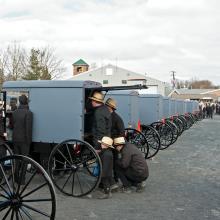reality TV
SOME TV SHOWS are as great as our greatest literature. Programs such as The Sopranos, The Wire, Mad Men, and Breaking Bad are Dickensian in their sprawl and Shakespearean in their tragic characters’ deceptions. But one show in this current Golden Age of television is the most oft-overlooked of its peers, one whose greater feat—or unfairness to screenwriters—is that it’s not scripted. I’m talking about A&E’s reality show Hoarders.
I’m not kidding. What often draws people to watch those suffering from hoarding disorder and the psychologists, professional organizers, and loved ones trying to help them overcome mental illness is the typical reality TV magnet: Seeing the life of someone worse off than you. But there’s more to Hoarders than that. A good episode is nothing less than a short story similar to those by Alice Munro, vivid in its deep analysis of real life, family dynamics, and psyches in danger and repair. Almost every night for the past month, watching has been like studying fiction writing in some of the best (and cheapest) creative writing courses I’ve ever taken.
IN MIDDLE SCHOOL I emailed CBS and asked them to make a teen version of their reality show Big Brother, in the hope that they would cast me and I could schmooze and deceive my peers to win the contest’s $500,000 prize. Schmooze and deceive weren’t my bright ideas: They formed a strategy I had seen succeed on previous seasons of Big Brother and Survivor, as clueless heroes were undone by ruthless, money-hungry, victorious villains. Even CBS’ clean-fun competition The Amazing Race had enabled contestants to backstab another team for $1 million.
So it’s unexpected that the network’s newer prime-time contest Tough as Nails plays to kinder rules—and that it has become part of my mostly drama-filled viewing habits. Twelve Americans with some of the most strenuous jobs that exist (welder, farmer, firefighter, ironworker, and more) vie in team and individual challenges to see who’s the hardest and smartest worker. As an artsy guy whose most physically demanding professional activity is typing, I would not have pictured myself in the Tough as Nails fan base. And yet, here I am.
Within the last sixty years, numerous pastors have used new forms of media — beginning with television — to reach thousands of people eager for their message. Pat Robertson founded the Christian Broadcasting Network, which continues to appeal to millions of people around the world. Joel Osteen’s ministry is broadcasted into every U.S. television market. And Billy Graham, arguably one of the most famous evangelical pastors, started radio and television programs, as well as numerous books, a magazine, and a syndicated newspaper column. Before hipster Christianity was on Instagram, these televangelists utilized methods of evangelizing considered new and strange.

Josh Canfield and Reed Kelly previously competed on the reality TV show “Survivor.” Photo courtesy of Monty Brinton / CBS ©2014 CBS Broadcasting Inc. / RNS
Canfield and Kelly have decided to keep singing each Sunday at Hillsong, despite the restrictions. They recognize that the decision they’ve made is not one that every person in their position should make. But they believe it is the right one for them.
“If every gay person leaves their church because they have been treated poorly, nothing will change,” Canfield said.
“They still want us, and we feel called to stay. And we’re telling all our gay friends at Hillsong to do the same.”

Photo via ABC / Image Group LA / Flickr
Caitlyn Jenner, Olympic athlete turned world-class glamour girl, took the planet by storm in June when she sat down for an interview with Diane Sawyer and announced her ongoing transition from male to female.
Now she’s back with an eight-episode miniseries, I Am Cait, that debuted July 26 on E!. The show, which airs in 154 countries and in 24 languages, serves as both classic reality TV lookie-loo entertainment and a spiritual exercise. Even the most Kardashian-resistant viewer can get something out of it.
Philosopher Martin Buber said, “All journeys have secret destinations of which the traveler is unaware,” and it’s clear from the very first moments of I Am Cait, when we see Jenner lying awake strafed by insomnia at 4:32 a.m., that she’s not sure where this whole thing is headed.
“What a responsibility I have,” she says to her camera bare-faced and bleary eyed.
“I just hope I get it right. I hope I get it right.”
If a briefcase of money fell in your lap, would you keep it, share it, or give it all away?
The new reality show The Briefcase is asking that question. But viewers and ethicists are asking more:
How could CBS put this on the air? Are there better ways to address the financial challenges of the middle class?
The hourlong show, which airs its fourth episode June 17, introduces two families each episode with the struggles of bills and not enough money coming in to achieve all their goals — whether dealing with a lost job, medical bills, or the potential costs of in vitro fertilization.
They’ve rescued bars and restaurants and shabby houses, but this month reality television stars are set to rescue something new.
Church Rescue will debut Monday on the National Geographic Channel, featuring the most unlikely of reality TV stars: church consultants.
The series will feature three “Church Hoppers”: the Rev. Kevin “Rev Kev” Annas, a business analyst; the Rev. Anthony “Gladamere” Lockhart, a marketing specialist; and the Rev. Jerry “Doc” Bentley, a spiritual counselor.
“The Church Hoppers exist to build balance in church through systems, business, and marketing,” said Lockhart, who like his fellow rescuers comes out of the Southern Baptist Convention.
Go Here to read the second in this series, Competing for the Greater Good
Peru is a land of extremes, especially for a motorcycle pilgrimage. Our journey from Lima to the orphanage in Moquegua took us through some of the most severe riding conditions imaginable. Storms of Peru, the second segment in the Neale Bayly Rides series, provided a glimpse into the challenges we faced, as Peru would not give up her beauty easily.
Our ride began in the congested, chaotic streets of Lima — a thriving metropolis of 16 million people — where an aggressive riding posture is your only chance for survival. It’s not that the Peruvians are bad drivers; it’s just that traffic laws don’t seem to be a concern for any of them. Riding through the boiling cauldron of cars felt like a massive vehicular free-for-all. Lima provided a baptism by fire for our adventure and, exciting though it was, we were glad to leave the haphazard traffic behind us.
We rode south toward the beautiful but haunting desert of Ica. The life-smothering heat and blowing sands sweep across the land and stop abruptly at the Pacific Ocean. Riding through the rugged terrain of crushed rock, sugar sand, and loose gravel was even more challenging than it appeared on television. I was glad the production team didn’t show everything. I bit the dust more times than I care to admit.
The country is amazingly beautiful, as are the people. There's a crazy juxtaposition of things you have to see to believe — poverty mixed with joy, beauty and brokenness in the very same face, a fierce gratitude in the meanest of circumstances.
Meet Amanda, Casey, Ashlee, Chanel, Joey, and Erica. They spend their time and their parents’ money shopping for designer labels, searching for rich husbands, and lounging by the pool with a glass of wine in hand.
They’re self-admitted “Jewish American Princesses,” and Bravo’s built a whole reality series, "Princesses: Long Island" around their exploits. The show follows six unmarried 20-something Jewish women living with their parents on New York’s Long Island. The first two episodes were titled “You Had Me at Shalom” and “Shabbocalypse Now.”
“Everybody has a stereotype of a Long Island Jewish girl,” cast member Ashlee White said on the show’s June 2 premiere. “People get so offended! I’m like, ‘Bring it.’ I’m Jewish, I’m American, and I’m a princess.”
And that’s where some Jews — and even some Long Islanders — have a problem.
ONE SUNDAY EVENING during high school, friends from my Mennonite church and I drove around Lancaster County, Pa., stealing mattresses. Bored by too many evenings of roller skating and Truth or Dare, we, like teenagers everywhere, landed on thievery as the solution to adolescent ennui. Having found out which of our friends were away from home, we showed up at their houses, told their parents about our prank, and swore them to secrecy. Then we clomped up narrow staircases to their sons’ and daughters’ bedrooms and wrestled mattresses back downstairs and onto the bed of a pickup truck. Just before our getaways, we left notes on our friends’ dressers, signed with what we thought was a most clever alias: “The Mennonite Mafia.”
We had no idea that 25 years later, Amish Mafia would be a blockbuster reality show, its first episode attracting 10 times more viewers than there are Amish people. Had you told us then that a bunch of Amish and Mennonite kids growing up a few miles away would someday parlay boredom-induced shenanigans into a hit cable TV series, I don’t know whether we would have been flattered or jealous. Kate Stoltzfus? Rebecca Byler? Lebanon Levi? People with names like these—our “plain-dressing” Amish neighbors and the more conservative Mennonite kids we went to school with—were the butt of our jokes, not the cynosures of popular culture.
Only a few decades after we and our families exited the conspicuous conservatism of plain Anabaptism, mass culture is flocking toward it. From Amish-themed reality TV shows to Christian romance novels with Amish characters and settings, the media have finally landed the lucrative Amish account, although the furniture industry and “Weird Al” Yankovic’s “Amish Paradise” got there first. Americans’ enthrallment with the Amish—and schadenfreude about their sometimes wayward youth—has rarely been more intense.
New Law Aims To Shine Light on Conflict Metals; Immigration Effort Mistakenly Holds U.S. Citizens; North Korea’s Persecution of Christians Expected to Continue After Kim Jon Il’s Death; Muslims push Lowe’s boycott over reality series; Two Muslim religious leaders sue airlines for discrimination; Christianity goes global as world’s largest religion; (Opinion) Obama’s simplistic view of income inequality.
So I'm a fan of So You Think You Can Dance. I enjoy watching dance and I used to dance, so I like the show even though it is a mostly scripted reality TV program.








